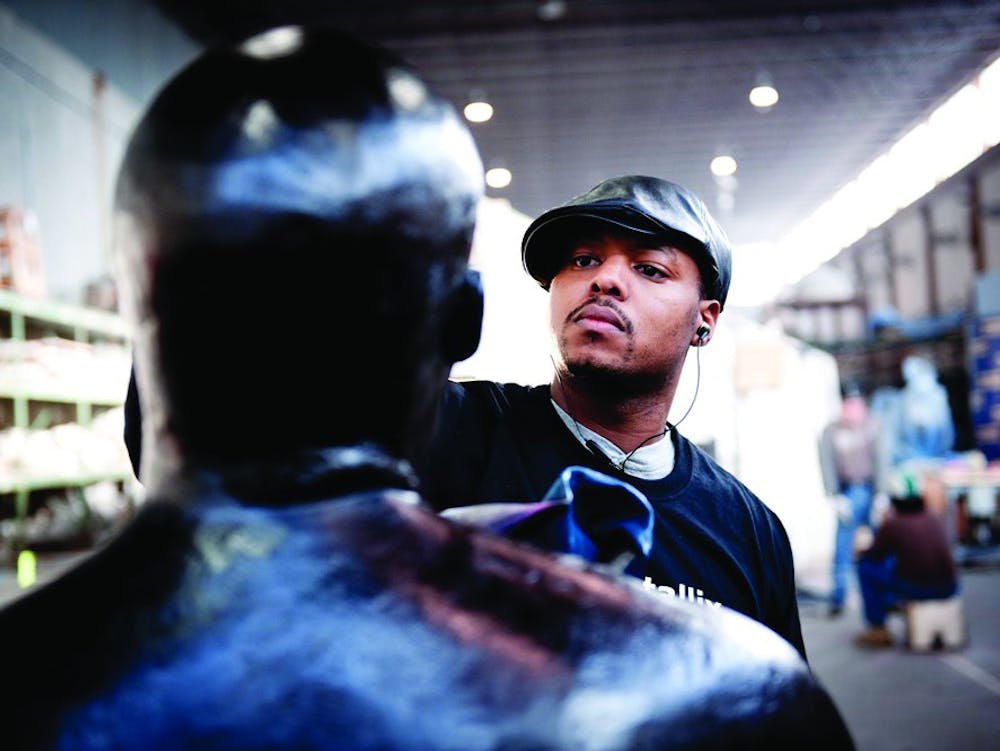In Titus Kaphar’s “Behind the Myth of Benevolence,” Thomas Jefferson exists on a five-foot canvas, but the black woman seated behind his likeness indicates a bigger picture.
Kaphar, a New Haven-based artist and 2018 MacArthur Fellow, will hold a public conversation Thursday, Jan. 16 entitled “Amending American Art, Making Space for Black History” with Dr. Jasmine Nichole Cobb at the Nasher auditorium. The free event, co-sponsored by the From Slavery to Freedom Lab at the John Hope Franklin Humanities Institute, is the keynote of “Black Images, Black Histories,” a two-day conference examining cultural representations of blackness.
“The role of images in popular culture, to me, is that images grab people in a way that books don’t always do,” Cobb said. “If you’re just with your family killing time at a museum and you see an image, it can spark a curiosity about something you never would’ve picked up a book on.”
As a professor of African & African American Studies and art history at Duke, Cobb became a fan of Kaphar’s work while using it to supplement “African Americans & the U.S. Presidency,” a project that originated in her Fall 2018 “Introduction to African & African American Studies” course. Many of Kaphar’s works examine past representations of glorified American historical figures by portraying the often-ignored problematic aspects of their legacies, such as “Benevolence” and “The Cost of Removal,” an altered portrait of Andrew Jackson juxtaposed with his oppressive Indian Removal Act.
“[Kaphar] is interested in amending the history of art. He makes us think of the history of all these great men with portraits and what the life they were living was while [those portraits] were being created,” Cobb said. “We can think about that as relevant to any ‘great’ man, whether it be Thomas Jefferson or James B. Duke — who are they besides this individual immortalized in a piece of art?”
Many storied American universities and their founders — almost ubiquitously upper-class white men — have roots in racism that their modern-day communities must reckon with. Several of Kaphar’s projects have confronted these histories, such as “Impressions of Liberty,” an installation at Princeton University responding to records of slaves sold on its campus by former president Samuel Finley. For his own alma mater, Yale University, Kaphar created “Enough About You,” a painting that sheds light on the life of a young boy once enslaved by the school’s namesake, Elihu Yale.
Concerning public art associated with slavery, Kaphar “has some interesting ideas that I think people in the Triangle could benefit from hearing about, given Silent Sam and UNC giving 2.5 million to the Sons of Confederate Veterans,” Cobb said. “I think his work is timely and relevant to Triangle audiences.”
Duke itself is no stranger to reckoning with controversies surrounding its own monuments. The university removed a statue of Robert E. Lee from campus in 2017 after it was vandalized following white supremacist riots in Charlottesville, Va., over the removal of another monument to Lee on the University of Virginia’s campus. In early 2019, the university installed a stone plaque in Abele Quad honoring Julian Abele, a black architect who designed much of West Campus in the 1920s. The commemoration was the result of decades of dedicated efforts to bring Abele’s legacy to light after his contributions were publicized by his great-grandniece in 1986.
Duke arts stalwarts Sarah Schroth, director of the Nasher Museum, and Scott Lindroth, vice provost for the arts, will both retire at the end of the 2019-20 academic year. According to Cobb, the need to bring in new blood allows for an “exciting” opportunity to jolt the university’s current arts culture, particularly by expanding the variety of black artists featured on campus.
“I’ve seen a number of prominent black artists and works by artists of color come through the Nasher in my time here, but I think there’s always room for more,” Cobb said. “There’s always room for growth.”
The necessity for more diverse art on campus and in the world is what the conversation aims to elucidate for the Duke community. On Thursday, doors will open at 5 p.m. for a reception prior to the event, which will take place from 6 to 7 p.m.
“By coming to the event, there’s a chance for people to think about their own relationship to images and put images in context,” Cobb said. “I hope they’re inspired to … think more deeply about images that they think they know well. To not just look at a portrait of a significant figure, but consider what it means to be thought of as significant enough to get a portrait at all.”
Get The Chronicle straight to your inbox
Signup for our weekly newsletter. Cancel at any time.

